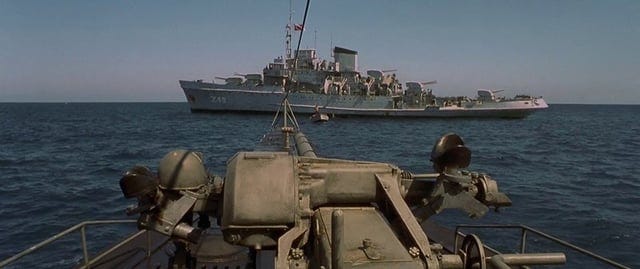Welcome back to Sullivan CapitalMap — where we aim to help you analyze more and understand better by cutting through the noise with independent geopolitical and financial insight.
As great power competition returns to the world’s oceans, chokepoints such as the Strait of Hormuz, South China Sea, and Bab el-Mandeb are becoming militarized zones of contestation. The U.S. naval withdrawal from global policing has emboldened regional powers to assert control, reshaping global trade routes, insurance risk models, and defense spending patterns. By 2030, naval power will be a leading driver of geopolitical leverage—and vulnerability.
The End of Maritime Free-Ride Economics:
For decades, the U.S. Navy functioned as the underwriter of global maritime security, ensuring freedom of navigation and uninterrupted global trade. At its Cold War peak, the U.S. deployed nearly 600 ships. By 2025, that figure hovers below 300 active ships, including fewer than 100 major surface combatants.
This retrenchment has allowed strategic rivals to test boundaries. China, Iran, and even private actors (such as Houthis backed by Iranian logistics) are engaging in targeted disruption of global trade corridors. Meanwhile, insurance costs for maritime shipping through contested waters have surged.
Data point: In Q1 2024, war-risk insurance premiums for container ships crossing the Red Sea rose from 0.05% to 1.2% of cargo value—24x higher year-over-year, according to Lloyd’s Market Association.
The Geopolitical Value of Chokepoints:
Roughly 90% of global trade moves by sea, with about 50% of daily oil exports passing through just seven key maritime chokepoints:
Chokepoint: Daily Oil Transit (Mb/d), Strategic Controller
Strait of Hormuz: 20.5 Iran, U.S., UAE
Strait of Malacca: 16.0 Indonesia, Singapore, China
Suez Canal/Red Sea: 9.2 Egypt, U.S. 5th Fleet, EU
Bab el-Mandeb: 6.2 Djibouti, Yemen, Iran proxies
Turkish Straits: 2.4 Turkey
Panama Canal: 0.8 Panama, U.S. influence
Danish Straits: <1.0 NATO, Russia near Baltic Sea
By 2030, China's People's Liberation Army Navy (PLAN) is projected to operate over 460 ships, including 6 aircraft carriers and multiple long-range anti-ship missile systems like the DF-26 “carrier killer.” Meanwhile, Iran has expanded its maritime militias with drone swarms and fast-attack craft tactics that have disrupted over 50 commercial vessels in the past 24 months.
The Rise of Regional Naval Spheres:
The U.S. continues to operate forward bases in Japan, Bahrain, and Guam, but its global naval architecture is being outpaced by the proliferation of regional naval coalitions:
China–Pakistan Maritime Axis via Gwadar and Hambantota
India–Vietnam–Philippines trilateral coordination
France–Japan Indo-Pacific security pact
Gulf Arab states investing in Western shipbuilding tech (UAE has ordered 8 new corvettes)
Meanwhile, NATO has increased patrols in the Arctic and Mediterranean, but is overstretched. The EU is still dependent on fragmented national navies—many of which are budget-constrained.
Data point: The Indian Navy is budgeted for $23.5B in capital spending between 2025–2030, focused on carrier expansion, nuclear subs, and hypersonic naval missiles.
Insurance, Trade, and the Weaponization of Risk:
Insurers are increasingly modeling geopolitical conflict scenarios that include maritime seizure, blockades, or kinetic conflict. This is being priced into global trade.
War risk insurance in the South China Sea has increased 340% since 2021.
Bulk carrier detainment events in the Red Sea have cut transit volumes through the Suez Canal by 42% YoY.
Logistics platforms like Flexport are rerouting vessels around the Cape of Good Hope—adding 10–14 days and 30%+ in fuel costs.
The Next Decade: Scenarios for 2030
Base Case:
The U.S. continues scaled-down forward presence, with coalition support, and global trade adjusts via dynamic rerouting. Chokepoint control is contested but navigable.
Geopolitical Risk Case:
A China–Taiwan conflict, Houthi escalation, or Iran–Israel maritime war could blockade one or more chokepoints for months, freezing $4–6 trillion in annualized trade and triggering a multi-front logistics crisis.
Investment Implication:
Shipping and marine insurance firms are repricing premiums at higher baselines.
Defense contractors specializing in naval surveillance, autonomous underwater vehicles, and hypersonic anti-ship tech stand to benefit.
Commodities markets, especially energy and grains, are increasingly chokepoint-sensitive.
Conclusion: Naval Power Is the New Geoeconomic Leverage
In an era of fragmenting global order, naval militarization is not a legacy concern—it is the front line of global economic friction. For investors, insurers, and governments alike, chokepoint control may define the winners and losers of the next geopolitical cycle.
Thank you for reading. Subscribe for continued insights on global trade dislocations, cross-border inflation, and the strategic systems behind the grocery store.



